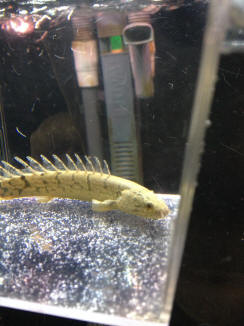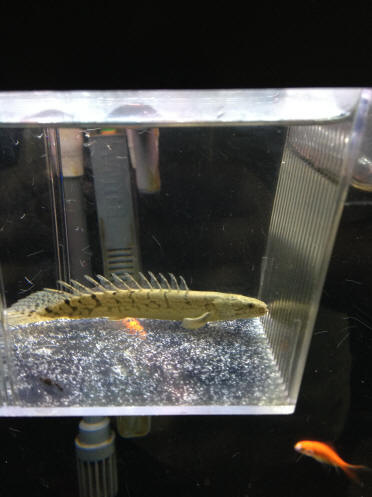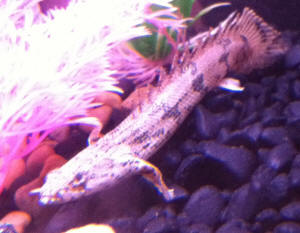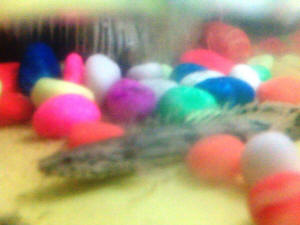|
FAQs on Bichirs, Family
Polypteridae Identification
Related Articles: Bichirs,
Related FAQs: Bichirs 1, & Bichir Behavior, Bichir Compatibility, Bichir Selection, Bichir Systems, Bichir Feeding, Bichir Disease, Bichir Reproduction, & FAQs on:
Ropefish 1, Ropefish 2, & Ropefish ID, Ropefish Behavior, Ropefish Compatibility, Ropefish Selection, Ropefish Systems, Ropefish Feeding, Ropefish Health, Ropefish
Reproduction,
|

|
|
Please ID for me desperate
12/27/14
Is this a delhezi or weeksii? I bought as weeksii but not sure please
help I beg u!!!!
<Doesn't have the greenish sheen or prominent black saddles of
Polypterus delhezi, that's for sure. But you can go by the number of
dorsal finlets.
On P. delhezi there are 10-13, while P. weeksii has 9-11. Your photo
doesn't have the entire fish so you'll have to count them yourself! Can
I further direct you to the relevant Fishbase pages:
http://www.fishbase.org/summary/Polypterus-delhezi.html
http://www.fishbase.org/summary/Polypterus-weeksii.html
You can find a range of diagnostic differences such as the colouration
of the pectoral fins (more yellowy on P. delhezi) and the size of the
upper
jaw (typically equal to lower jaw on P. delhezi but upper jaw slightly
more
prominent on P. weeksii). There are some hybrids in the trade, so even
with
Fishbase helping you, you can still find specimens that don't match
either
species. Cheers, Neale.>
|

|
Please help ID bichir
12/27/14
This guy has 11 finlets but doesn't help cuz so can delhezi...
<Could well be a young P. delhezi. The stripes towards the back end of
the fish are quite sharp, unlike the more broad and blurry bars seen on
P. weeksii.>
I spent a lot of $$$ at liveaquaria.com
<Slightly worried about the goldfish in there then! Just to be clear,
feeder goldfish are an extremely bad idea. No responsible, intelligent
aquarist uses them. I'm not against live food per se, and in some cases,
as with South American Leaffish, home-bred feeder Guppies are pretty
much the only option. But store-bought Goldfish are parasite time bombs
that have
too much fat and Thiaminase in them to be useful even if you sterilised
them beforehand! Polypterus delhezi are very adaptable, and will take
sensible foods such as cockles, tilapia fillet and squid, alongside
treats like gut-loaded river shrimps and earthworms.>
They have sent me wrong fish in the past.
<So let's try and keep this lovely specimen healthy then!>
Really need help
<My therapist says much the same thing. Anyway, cheers, Neale.> |
 |
|
Re: Please help ID bichir
12/27/14
Hello
Can u ask somebody else who has a lot of knowledge in bichirs for a second
option?
<Sorry Jason, don't have that kind of time, even for folks who say "please"
and "thank-you".>
What should I look for that one has but not the other?
<See Fishbase. Aquarist know-how is somewhat less reliable that scientific
resources. Cheers, Neale.>
Re: Please help ID bichir
12/27/14
I find that fish base is garbage only confirmed what I already knew-dorsal
spines.
<Fishbase is a compilation of primary taxonomy, i.e., how scientists
described the species in the first place. It isn't user friendly in the
sense it isn't designed for aquarists. Fish scientists would identify a
bichir on the basis of what's called a "suite" of characters, such as scale
counts, head length to body length ratios, and of course fin spine counts.
Taken together, these are very reliable. You're asking for a single way to
tell P. delhezi apart from P. weeksii, but unfortunately for you, some
specimens from either species may seem "intermediate" in regard to
colouration and the number of dorsal finlets. Realistically, P. delhezi
tends to have much sharper dark saddles compared to the more blurry, almost
marbled patches you see on the average P. weeksii. So you could use that
fact that yours has pretty sharp saddles to assume yours is P. delhezi. But
it isn't beyond the realms yours is a hybrid or a P. weeksii with unusually
sharp marbling. In time it should become more clearer as older specimens of
P. weeksii develop quite broad heads even by bichir standards as well as an
overall mottled, marbled colouration distinct from the sharp bands of
classic P. delhezi. But as I say, many farmed fish sold as P. delhezi are
hybrids or simply not especially good specimens, and such fish seem to lack
the perfectly sharp black saddles seen on wild-caught P. delhezi. Monster
Fishkeepers is probably the best place to get help with bichirs, though by
European standards some of the aquarists there are a bit free with feeder
fish! But a lot of expert fishkeepers there. WaterWolves is another
predator-oriented website you'd enjoy.>
please and thank you
<Welcome. Neale.> |
|
|
questions regarding new baby bichir, ID, sys., diet...
9/27/12
Hello,
<Hello,>
I have previously owned bichirs, and currently own a delhezi bichir and
Senegal bichir (separate tanks). in my third tank, I have recently gotten a
baby bichir. he looks like a saddled bichir but I am not sure. (see attached
pictures). His personality is very similar to my first bichir, which I
believe was saddled. He is very energetic, and likes to sit on top of the
plants, or squeeze between the heater and the tank wall. He looks like he is
hunting, but he is in there alone. Can you identify him for me?
<Looks like some sort of Polypterus delhezi to me, but the photos aren't
terribly sharp. Also, please do note we specifically ask for images no
bigger than around 500 KB a piece -- sending 7+ MB of images clogs up our
e-mail account and takes a while to download.>
In addition, what would be suitable tank decor for a baby bichir? What decor
do they seem to like? (my other two bichirs are duds and sit on the bottom)
<None of the Bichirs are terribly active; that's their nature. Generally, go
for a smooth substrate (so as not to scratch them when they root about) and
plenty of shade. Live plants are ideal, especially floating plants. If you
use plants that root themselves in the substrate, choose robust species not
easily uprooted, such as Giant Vallisneria or Amazon Swords. Otherwise,
epiphytes like Java Fern and Anubias are ideal, and also happen to tolerate
shade well.>
Also, what would be a good diet for a baby bichir? I'd prefer not to handle
raw meats/fish.
<You may prefer not to, but if you buy a Bichir, that's what you're getting
into. Fresh or frozen cockles and strips of tilapia fillet are two ideal
foods, being inexpensive and Thiaminase-free. Mussels and prawns may be
used, but sparingly because they contain Thiaminase, and long-term, too much
Thiaminase can and does cause serious health problems. Live river shrimp and
earthworms are good foods for subadults and adults, while very small
juveniles may do better with things like bloodworms. Most specimens can be
weaned onto good quality pellet foods such as Hikari Sinking Carnivore
pellets.>
I heard that feeding live goldfish was bad,
<Extremely bad.>
does the same go for feeder minnows/tuffys?
<Yes.>
Are there any frozen foods that would be good for him?
<See above.>
He doesn't seem too into pellets, and the store where I purchased him said
he had quite a few fish.
<Not a good sign. Sadly, in the United States especially, there's still a
huge ignorance about the dangers posed by feeding live fish, especially
minnows and goldfish, to carnivorous fish. Here in England aquarists keep
the exact same carnivorous fish and never touch live feeder fish. Since
we're all buying the same tropical fish exported from the same countries,
it's a mystery to me why American aquarists (and significantly, American
retailers) insist on using live feeder fish known to be Thiaminase-rich and
riddled with parasites. If you must use live feeders, choose a safe
livebearing species, deworm them, and then breed from them your own feeders.
Gut load before use. But as I say, there's absolutely no need to do this,
and doing the alternative and using fresh/frozen foods will be cheaper,
safer, easier, and less likely to cause problematic behaviours such as
aggression.>
I just want this little guy to have the best life he can, and I'm willing to
do almost anything to make him happy, he is already a very special fish.
Thanks so much and have a great day!
Alyssa
<Glad to help, Neale.>
|
 |
|
Is this also a Polypterus? 2/20/12
Hello Mr. Bob Fenner,
<Ben>
Greetings!
<Selamat pagi>
I hope you're not getting bored with my e-mails about
Polypterus and their antics. I just bought a fish, which the fish
store guy swore that it is another Polypterus species. Could you
identify this little guy? I attached two pictures of him(or
her?).
<Mmm, maybe P. delhezi... Do see here:
http://www.wetwebmedia.com/FWSubWebIndex/polypterids.htm
Since he is very small compared to my two other Dragonfishes, I
am afraid of bullying problem, so for now I isolated him in a
smaller tank, and feeding him Tubifex worms. Should I let him
living in a separate tank as for today, or would he live in peace
with my Dragonfishes?
<Likely would/will get along, if there's sufficient
room>
Thank you for your kind attention and assistance!
Best Regards,
Ben Haryo
PS: I have checked the website below, and discovered that the
venue of the event is in Borobudur, which is in another province
(in Central Java), far from my place. What is "Hashing"
anyway, is that some kind of cultural event?
<Is a "drinking group w/ a running problem"... Much
on the Net re. BobF>
|
|
 
|
| fish id 8/5/07 hello I was told this
was a baby Reedfish but think it may be a grey bichir help please
<Not the former... Is a species of Polypterus. BobF> |
|

|
| Thanks and Senegal bichir ID
05/09/08 Hi everybody, Thank you very much for running
this site, you have no idea how many times you have helped me! I
just wanted to follow up on an FAQ labeled "fish id" in
the Polypterid ID section on 8/5/07, it was a Senegal Bichir and I
now have two more, all of them healthy thanks to you guys and gals.
Thanks again -Tom <Thank you for the kind words and update.
-Sara M.> |
Senegal Bichirs/s Hi there my name is Jason from
Auckland, New Zealand, the other day I bought a couple of Senegal
Bichirs and I was wondering if there is any way of telling if they are
short body Senegal or normal ones, they are about 4inch. <Mmm, I am
not aware that there is any more than just the one species: http://www.wetwebmedia.com/FWSubWebIndex/polypterids.htm>
The pet shop that I bought them from told me that they were lung fish
but after searching the web for these fish I found that they are
Bichirs not lung fish, and that there are short and long body types.
Are you guys able to help? Cheers. <Please see the above link, and
read about the family on Fishbase.org Bob Fenner>
|
|

